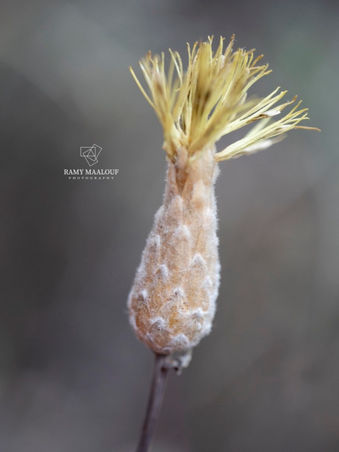Family |
Asteraceae
Klasea cerinthifolia
(Sm.) Greuter & Wagenitz
Klasea cerinthifolia (Sm.) Greuter & Wagenitz
(Willdenowia 33: 58; 2003 – basionym: Serratula cerinthifolia Sm., Fl. Graec. Prodr. 2: 126; 1813 – Nouvelle Flore du Liban et de la Syrie, vol. 2, Pl. CCVIII nº 1; 1969)
• Life-form & habit: Perennial herb 40–100 cm tall, with a thick woody rhizome and erect, unbranched or sparsely branched stems. Plant greyish-green, somewhat tomentose especially beneath the leaves and on young parts.
• Leaves: Basal and lower cauline leaves oblong-lanceolate, 10–25 × 2–6 cm, entire or faintly denticulate, tapering into a winged petiole; upper leaves smaller, sessile, amplexicaul, and more densely tomentose. Upper surface green and nearly glabrous, underside greyish or white-tomentose.
• Inflorescence & flowers: Capitula large (2–4 cm), solitary or few, terminal on stems and branches. Involucre broadly campanulate, 15–25 mm, with several series of overlapping, often purplish-tipped phyllaries. Florets all tubular, purple to lilac; corolla 12–15 mm, exserted beyond the involucre; anthers and styles prominently projecting.
• Fruit: Achenes oblong, 3–4 mm, striate, pale brown; pappus of scabrid, whitish bristles slightly unequal in length.
• Phenology: Flowers and fruits from June to August.
• Habitat & elevation: Dry montane slopes, rocky pastures, and open scrub on limestone or marl, typically between 800 and 2 000 m.
• Lebanese distribution: Reported by Mouterde (as Serratula cerinthifolia) from Dahr el-Baïdar, Barouk, Sannine, Ras Baalbeck, and the Anti-Lebanon; frequent in subalpine zones.
• Native range: Cyprus, Iran, Iraq, Lebanon, Syria, Palestine, Türkiye (POWO).
• ⚠️ Taxonomic note: Formerly placed in Serratula; transferred to Klasea by Greuter & Wagenitz (2003) based on pappus and achene morphology. Differs from Klasea pinnatifida by its entire or weakly toothed leaves, tomentose underside, and larger solitary purple heads. A characteristic eastern Mediterranean and Levantine montane species.







